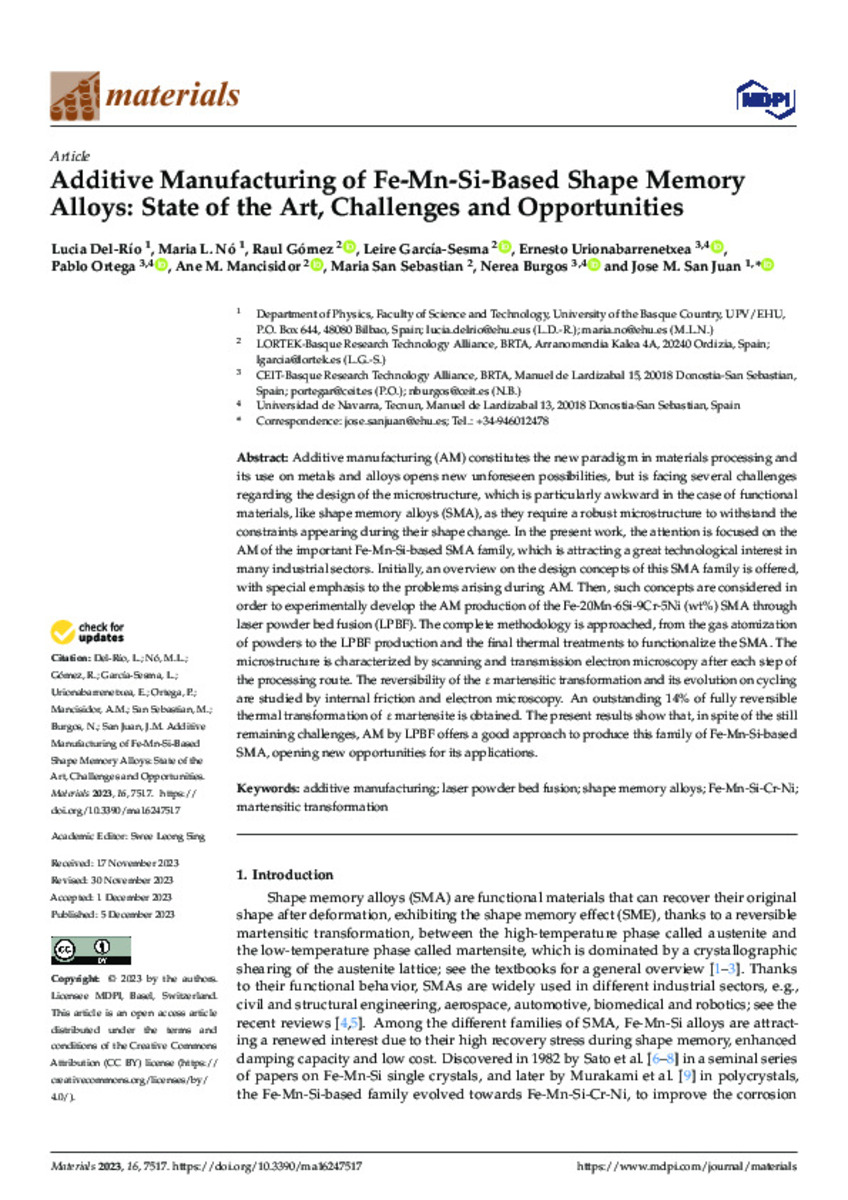Full metadata record
| DC Field | Value | Language |
|---|---|---|
| dc.creator | Del Rio, L. (Lucía) | - |
| dc.creator | No, M.L. (María L.) | - |
| dc.creator | Gómez, R. (Raúl) | - |
| dc.creator | García-Sesma, L. (Leire) | - |
| dc.creator | Urionabarrenetxea, E. (Ernesto) | - |
| dc.creator | Ortega, P. (Pablo) | - |
| dc.creator | Mancisidor, A. (Ane) | - |
| dc.creator | San Sebastián, M. (María) | - |
| dc.creator | Burgos-García, N. (Nerea) | - |
| dc.date.accessioned | 2024-01-19T08:05:33Z | - |
| dc.date.available | 2024-01-19T08:05:33Z | - |
| dc.date.issued | 2023-12 | - |
| dc.identifier.citation | Del-Río, L., Nó, M. L., Gómez, R., García-Sesma, L., Urionabarrenetxea, E., Ortega, P., ... & San Juan, J. M. (2023). Additive Manufacturing of Fe-Mn-Si-Based Shape Memory Alloys: State of the Art, Challenges and Opportunities. Materials, 16(24), 7517. | es_ES |
| dc.identifier.issn | 1996-1944 | - |
| dc.identifier.uri | https://hdl.handle.net/10171/68430 | - |
| dc.description.abstract | Additive manufacturing (AM) constitutes the new paradigm in materials processing and its use on metals and alloys opens new unforeseen possibilities, but is facing several challenges regarding the design of the microstructure, which is particularly awkward in the case of functional materials, like shape memory alloys (SMA), as they require a robust microstructure to withstand the constraints appearing during their shape change. In the present work, the attention is focused on the AM of the important Fe-Mn-Si-based SMA family, which is attracting a great technological interest in many industrial sectors. Initially, an overview on the design concepts of this SMA family is offered, with special emphasis to the problems arising during AM. Then, such concepts are considered in order to experimentally develop the AM production of the Fe-20Mn-6Si-9Cr-5Ni (wt%) SMA through laser powder bed fusion (LPBF). The complete methodology is approached, from the gas atomization of powders to the LPBF production and the final thermal treatments to functionalize the SMA. The microstructure is characterized by scanning and transmission electron microscopy after each step of the processing route. The reversibility of the epsilon martensitic transformation and its evolution on cycling are studied by internal friction and electron microscopy. An outstanding 14% of fully reversible thermal transformation of epsilon martensite is obtained. The present results show that, in spite of the still remaining challenges, AM by LPBF offers a good approach to produce this family of Fe-Mn-Si-based SMA, opening new opportunities for its applications. | es_ES |
| dc.language.iso | eng | es_ES |
| dc.publisher | MDPI | es_ES |
| dc.relation | This research was supported by the Industry Department of the Basque Government through the ELKARTEK-MINERVA (KK-2022/000082) project, and also from the GIU-021/24 from the University of the Basque Country UPV/EHU. This work made use of the electron microscopes installed at the General Service of Electron Microscopy of Materials, of the SGIKER—UPV/EHU, and the Zeiss at LORTEK technology center. Lucía Del-Río acknowledges the Pre-Doctoral grant (PRE_2022_1_0109) from the Education Department of the Basque Government. | es_ES |
| dc.rights | info:eu-repo/semantics/openAccess | es_ES |
| dc.subject | Additive manufacturing. | es_ES |
| dc.subject | Laser powder bed fusion | es_ES |
| dc.subject | Shape memory alloys. | es_ES |
| dc.subject | Fe-Mn-Si-Cr-Ni | es_ES |
| dc.subject | Martensitic transformation. | es_ES |
| dc.title | Additive manufacturing of Fe-Mn-Si-based shape memory alloys: state of the art, challenges and opportunities | es_ES |
| dc.type | info:eu-repo/semantics/article | es_ES |
| dc.editorial.note | This article is an open access article distributed under the terms and conditions of the Creative Commons Attribution (CC BY) license (https:// creativecommons.org/licenses/by/ 4.0/). | es_ES |
| dc.identifier.doi | 10.3390/ma16247517 | - |
Files in This Item:
Statistics and impact
Items in Dadun are protected by copyright, with all rights reserved, unless otherwise indicated.






